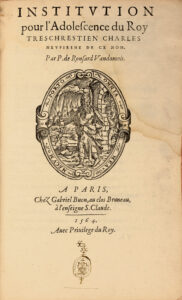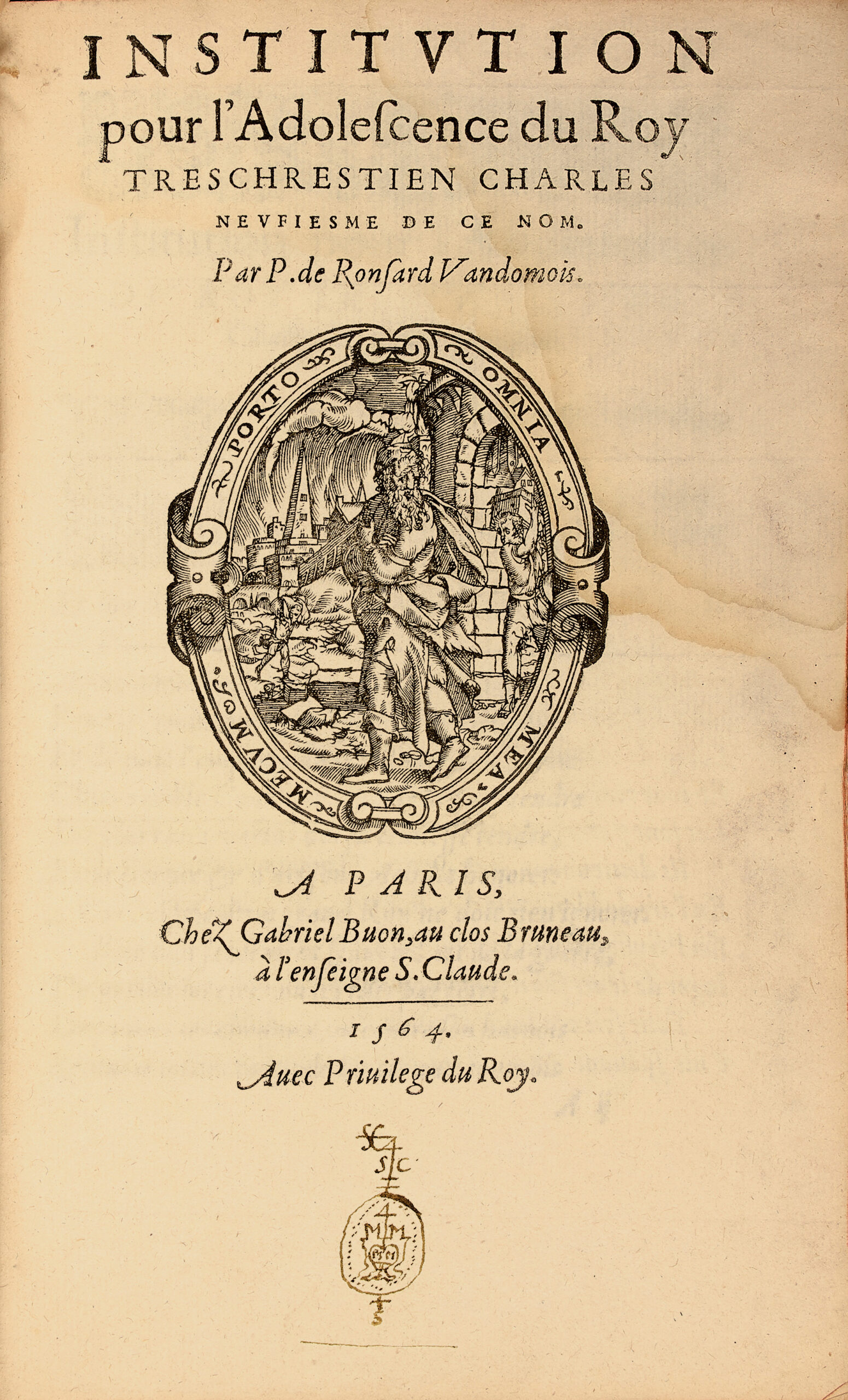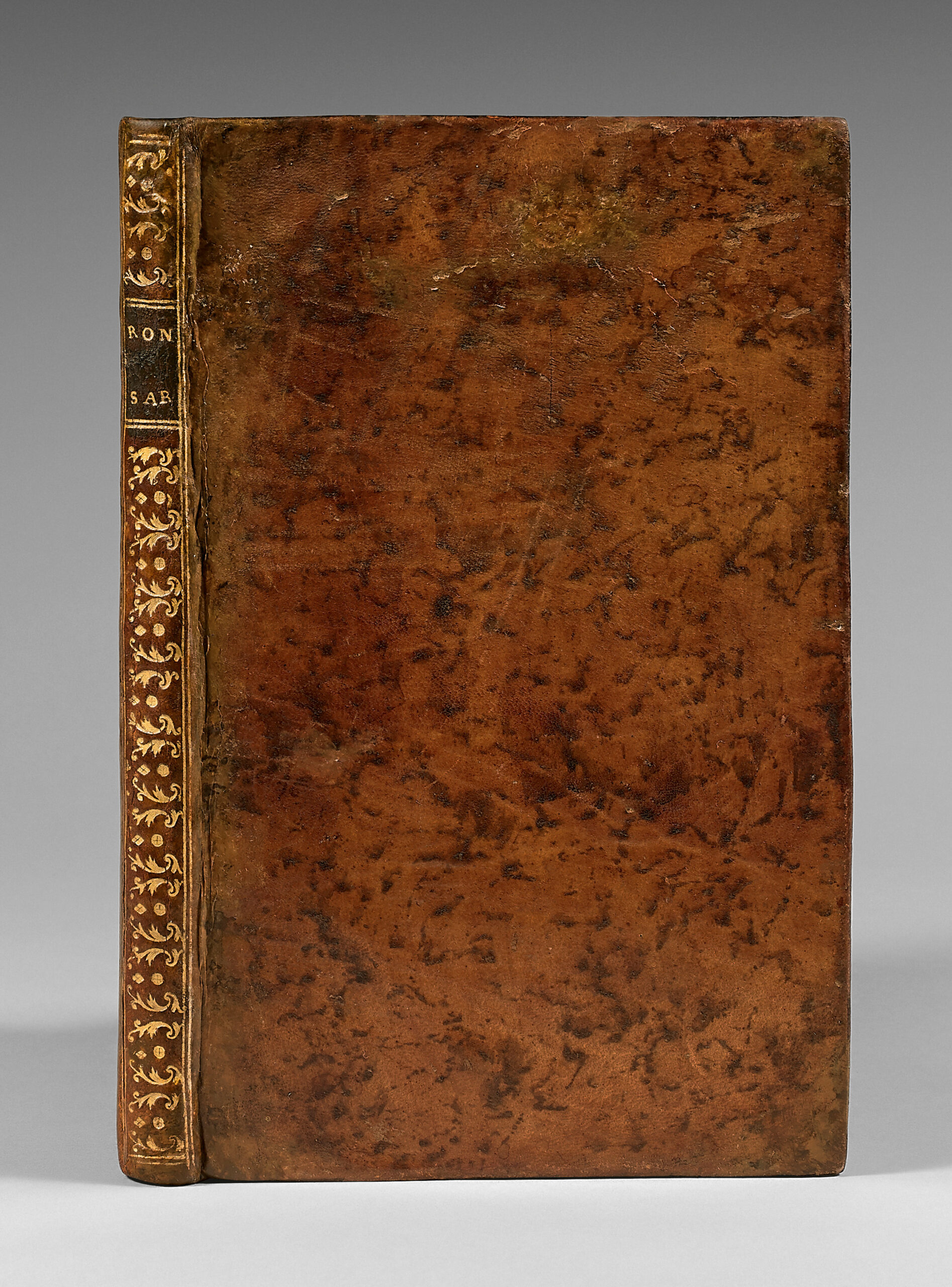Ronsard, Pierre de (1524-1585). Continuation Du Discours des Miseres de ce Temps. A La Royne Par P. de Ronsard Vandomois.
A Paris, chez Gabriel Buon, au clos Bruneau, à l’enseigne S. Claude, 1563.
4to of 10 ll., signed A to B by 4 and C by 2. Or:
“To my knowledge, this copy is the only one known (see Barbier, 4, n°45) of a first state of the second family of editions of 1563, which is characterized by:
– The privilege on the verso of folio 10 (and not on the verso of the title).
– A greater number of verses per page, so that the text ends on the front of folio 10 and not on the back.
– Shifting the beginning of the stanzas to the right” (Jean-Paul Barbier).
Full marbled calf, richly decorated flat spine, red edges, top of the spine restored. Bound around 1740.
214 x 133 mm.
According to Jean-Paul Barbier, only one copy is known: his, “washed, in a modern binding, 205 mm high”. The present copy is the second known, “unwashed, in an antique binding, 214 mm high”.
Extremely rare first state – of the second family of editions of 1563 of the ‘Continuation du Discours des Miseres de ce temps’.
“This edition of 1563 differs from the first of 1562 only by the date” mentions Tchemerzine..
“These original editions contain a number of verses that are not included in the collection of works printed in 1584 and since. In these speeches in verse, the author recounts with an energetic eloquence the evils that the Calvinists caused to France during the minority of Charles IX; this drew violent responses from the supporters of the reform” (Brunet).
In the Continuation du Discours des Miseres de ce temps (Continuation of the Discourse on the Miseries of this Time), Ronsard took up the defense of the Catholic party and, above all, the unity of France, which had been caught up in the turmoil since the Vassy massacre (1562). Théodore de Bèze’s opponent, but also a critic of the internal failings of the Church, Ronsard engaged in polemical combat, in which he suffered many pamphlets. Perhaps uncomfortable with these endless rivalries, but forced despite himself to lend his pen to the king’s party, the poet jointly produced these political epistles in verse and poems to the new Genèvre. The “royal poet” was in action, producing 14 highly varied discourses, all marked by a strong deliberative rhetoric and a mixture of noble and colloquial tones. Ronsard alternately admonishes, exhorts, deplores, advises and flatters his many readers, appealing to their consciences and urging them to act, in other words, for the poet, to respect the old order.
– Followed by : Ronsard, Pierre de. Institution pour l’Adolescence du Roy tres chrestien Charles Neuvième de ce nom.
A Paris, chez Gabriel Buon, 1564.
Only 4 copies recorded by J.P. Barbier.
6 leaves signed A by 4 and B by 2.
There are 26 verses on the current page, 16 verses on the first page of text and 14 verses on the last page (in the three editions of 1563, there were 18 verses on the first page, which subtracted two verses from the last page, the current pages remaining the same. There is an advertisement on the back of folio 4.
“To my knowledge, this is the only edition dated 1564. I have identified four copies: at Harvard, the Bibliothèque nationale, the Bibliothèque de l’Institut, and this one (Barbier 4, n°19)”. (Jean-Paul Barbier).
The Barbier copy, one of the four known, is washed, in a modern binding, 205 mm high; the present copy is unwashed, in an antique binding and measures 214 mm.
The poet’s advice to the eleven-year-old king he loved so much, whose untimely death later left him inconsolable, was largely inspired by a Latin epistle that the future chancellor Michel de l’Hospital had addressed to Charles IX’s brother François II in 1559 (“De sacra Francisci II. Galliarum regis initiatione…‘), and Joachim du Bellay’s translation of this epistle (’Discours sur le sacre du treschrestien Roy Françoys II…”). Although this play is ranked among the political speeches of the Vendôme region (and although it includes advice to punish seditionists), the quarrels sparked by religion are hardly mentioned. The Institution was written around the time of the failed Colloque de Poissy, in autumn 1561.
Following in the tradition of the advice given by Erasmus to the young Charles V and by Budé to François I, and sometimes departing word for word from the declarations and warnings uttered by the good L’Hospital, the Institution, composed ‘as a moralist, not a pamphleteer’ (R. Aulotte, in Renaissance Studies in Honor of I. Silver: 37), does not contain any powerfully original ideas. But the vigorous tone that was to characterise the Discourses of 1562-1563, the poet’s sense of harmony, vivacity and elevation of spirit are already evident in the first line, which sums up all the advice given later: ‘Sire, ce n’est pas tout que d’estre Roy de France,…’.
– Followed by : Ronsard, Pierre de. Elegie de P. de Ronsard Vandomois, sur les troubles d’Amboise, 1560. A. G. des Autels Gentilhomme Charrolois.
A Paris, chez Gabriel Buon, au clos Bruneau à l’enseigne S. Claude, 1563.
Only copy listed.
6 leaves, signed A by 4 and B by 2.
Unique edition and only copy recorded containing 28 full-page verses.
The extremely rare original edition of 1562 contains 27 lines per page.
“L’élégie sur les troubles d’Amboise first appeared in the collective edition of 1560 (part III, Cinquième Livre des Poèmes, from l. 215 verso to l. 219 verso). This is the first of Ronsard’s political discourses, whose extreme moderation can be seen.
We know that in 1560 the poet had recommended opposing the danger represented by the Reformation. This enemy, who was then to be found everywhere in the population, this seditionist who had attempted a coup de main against the château of Amboise where the royal family resided, had to be ‘par livres l’assaillir, par livres luy respondre ’.
In 1562, when civil war threatened, Le Vendômois had his poem reprinted as a booklet. And he continued to recommend the use of books as the only means of repression. I discovered the apparently unique copy of this version in the Bibliothèque Publique et Universitaire in Geneva (Barbier 4, n°1).
But on 1 March 1562, the Vassy scuffle set things alight. Seizing this pretext, the Protestant leaders buckled their breastplates and the poet changed his advice. The rebel deserved to be treated differently; he had to be ‘par armes l’assaillir, par armes lui respondre’.
This is the text we find here. It is the one that Buon alone reprinted during the first war of religion.
The Jean-Paul Barbier copy measures 206 mm, compared to 214 mm for this copy.
– Followed by : Ronsard, Pierre de. Remonstrance au peuple de France.
A Paris, chez Gabriel Buon, au clos Bruneau à l’enseigne S. Claude, 1564.
16 leaves signed A to D by 4.
There are 28 verses per page, 24 verses on l. (I) v°, and 8 verses on l. 16 v°. There are advertisements on the last leaf of quires A, B and C. The beginning of the stanzas is shifted to the right.
The only recorded edition dated 1564 (see Barbier 4, n°57). It is similar to the edition for which I have made the ‘fourth family’ of editions of 1563, with the difference that the beginning of the stanzas is shifted to the right rather than to the left.
The ‘fourth family’ of 1563 is characterized by the deletion of quire E, consisting of two leaves, the text now beginning on the verso of the title, and the privilege being moved to the verso of leaf 16, where it is placed after the end of the poem.
In addition, we note the correction of the line in which Ronsard reproaches Condé for having sent his brother Antoine de Navarre to his death (see Notice N°37, second line of l. 15 v°, reproduced). Here, we read this unmarked version (f. 14 v°, verse 22, reproduced above right): ‘Vostre frere avant l’âge au sepuichre envoyé…’.
The Jean-Paul Barbier copy, washed, in a modern binding, measures 205 mm; this one, unwashed in an antique binding, measures 214 mm.
– Followed with : Ronsard, Pierre de. Responce de P. de Ronsard Gentilhomme Vandomois, aux injures et calomnies, de ie ne sçay quels Predicans, & Ministres de Geneve.
A Paris, Chez Gabriel Buon, au clos Bruneau, à l’enseigne S. Claude. 1563.
26 leaves signed a to f by 4 and g by 2.
There are 28 verses per page, 16 on folio 3 v°. There is no advertisement at the end of the quires. “According to my research (Barbier: 145SS.), there are three families (each with different states) of editions of this work given in 1563 by Buon, the official publisher chosen by Ronsard. This copy belongs to the third family. Briefly, the situation can be summarized as follows:
a) first family
There is no headline in the margin of folio 12 r°, and verse 16 of folio 22 r° reads: ‘Et plus vous mesprisés...’. (for: ‘m’espuisés’). The second state begins on fol. 2 r° with the title ‘Epistre’, instead of ‘Epistre Au Lecteur’. Finally, the poem ‘In laudem Ronsardi’ is not found on the verso of folio 26 in the first state.
b) second family
The last word of the second line of the transport of the privilege, on the verso of folio I, is cut as follows: ‘calom-’, whereas ‘calomnies’ is found in the third family. Similarly, on folio 2 r°, the last word is ‘t’imprimer’ (‘une marque’ in the third family). Finally, on folio 25 r°, the tenth line ends with ‘seul-’ (‘seule -’ in the third family).
c) third family
(I have included the 1564 edition, despite a few tiny differences with the last edition of 1563). It contains the differences mentioned above (description of the second family) and other spelling or textual variants such as: ‘Or ce Dieu tout puissant…’ instead of ‘Or ce Dieu tout parfait…’ in verse 7 of folio 10 r° in the editions of the first and second families.
We should also mention the presence in the Bulletin de la Librairie Morgand (VIII, 1898-1899, n° 33269) of a copy bearing the date 1562. As the death of the Duc de Guise, to which Ronsard refers, occurred in 1563, the accuracy of this date is doubtful.
This poem is Ronsard’s next to last apostrophe to the protestants, the last being the Epistle which opens the Recueil des Nouvelles Poésies. Here he responds to three ‘petits livres’ which were ‘segrettement composz deux moys au paravant par quelques ministreaux… et depuis… imprimez à Orleans contre moy’.
I describe below my copy of the Protestant pamphlet, effectively divided into three parts, the first of which was signed A. Zamariel (pseudonym of Antoine de la Roche-Chandieu, Zamariel meaning ‘song of God’ in Hebrew), while the second and third were the work of a certain B. de Mont-Dieu, in whom we must certainly see Bernard de Montméja, ‘ia’ also meaning ‘God’ in Hebrew.
Let us add that Chandieu and Montmejà, whose pamphlet was entitled Response aux calomnies contenues au Discours et Suyte du Discours sur les Miseres de ce temps… intended to take revenge for the attacks launched by Ronsard against their co-religionists in the Discours des Misères de ce temps. What is remarkable about the Response described here is the dignified tone adopted by the poet. After beginning sarcastically by refuting the accusations made against him, he takes the debate to the level of the history of literature with extraordinary hauteur but without any arrogance […].
This already testifies to an exceptional personality. But what can be said of the way the master defends himself against the accusation of lasciviousness levelled against him, not without some justification? Someone else would have got bogged down in smoky denials, trying to explain that his tonsure did not prevent him from writing amorous verses, that he had not been ordained a priest despite his cures and abbeys, and so on.
On the contrary, with perfect ease and that freshness of tone that marks so many sonnets dedicated to Marie, our poet simply explains how one of his days goes by… It’s an exquisite account, too long to reproduce here, unfortunately, but one that I count among my favourite verses. I’ll just give you a sample:
« Jayme à faire l’amour, j’ayme à parler aux femmes,
A mettre par escrit mes amoureuses flammes,
J’ayme le bal, la dance, et les masques aussi,
La musicque et le luth, ennemis du souci.
Puis quand la nuit brunette a rangé les estoilles
Encourtinant le ciel et la terre de voilles,
Sans soucy je me couche, et là levant les yeux,
Et la bouche et le cueur vers la voute des cieux,
Je fais mon oraison, priant la bonté haute
De vouloir pardonner doucement à ma faute ».
(f. 13 v°).
The J.P. Barbier copy measures 189 mm high, the present copy, 214 mm.
A precious and remarkable volume in which a passionate of precious literature collected around 1740 five works by Pierre de Ronsard printed in 1563 and 1564 which were already at that time of great rarity, some of which being described by Jean-Paul Barbier as ‘unique known copy’.
This copy, bound around 1740, is wide-margined – one work is 25 mm larger than that of J.P. Barbier – and is unwashed (occasional stains and traces of old waterstains; marginal tear without loss of text on the last two leaves of the fifth work).


